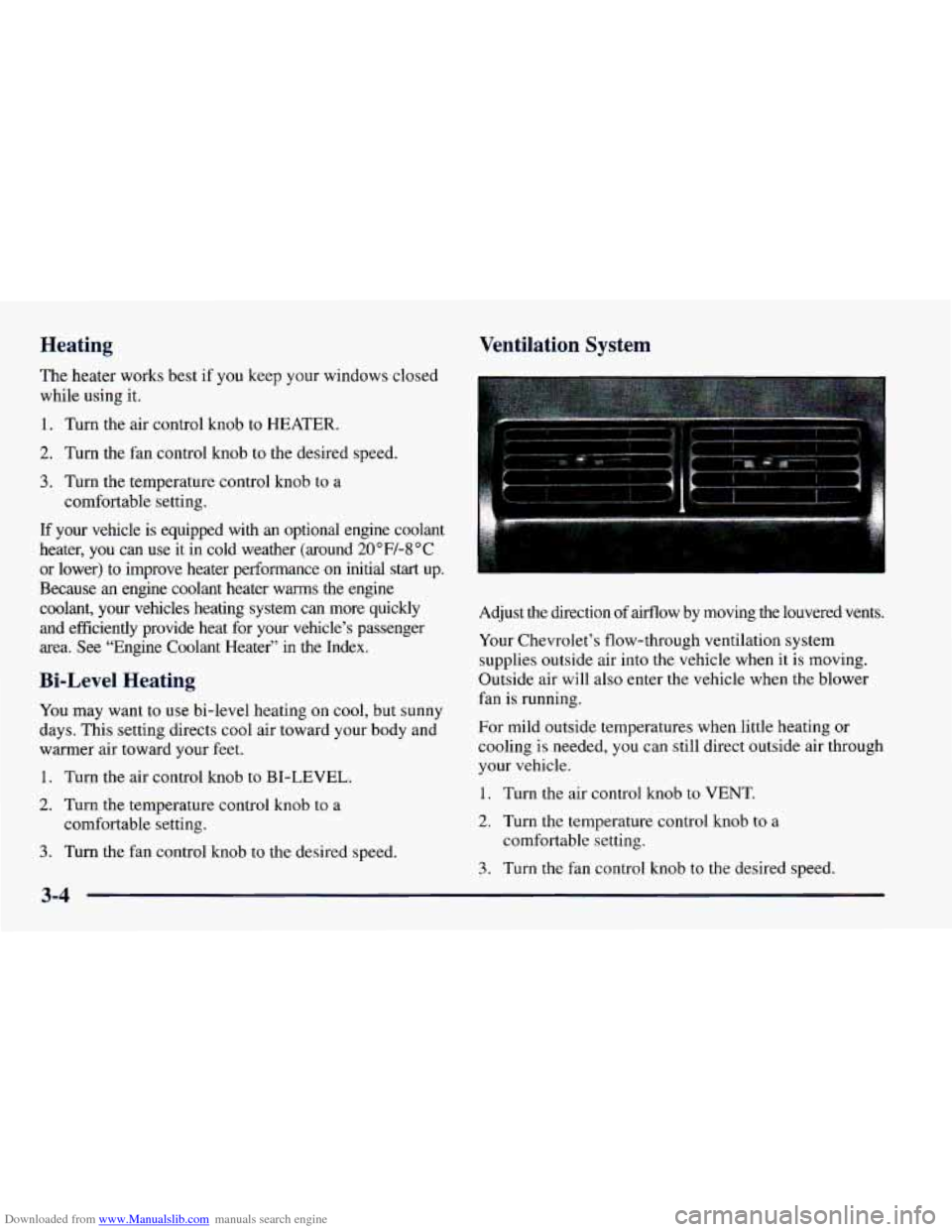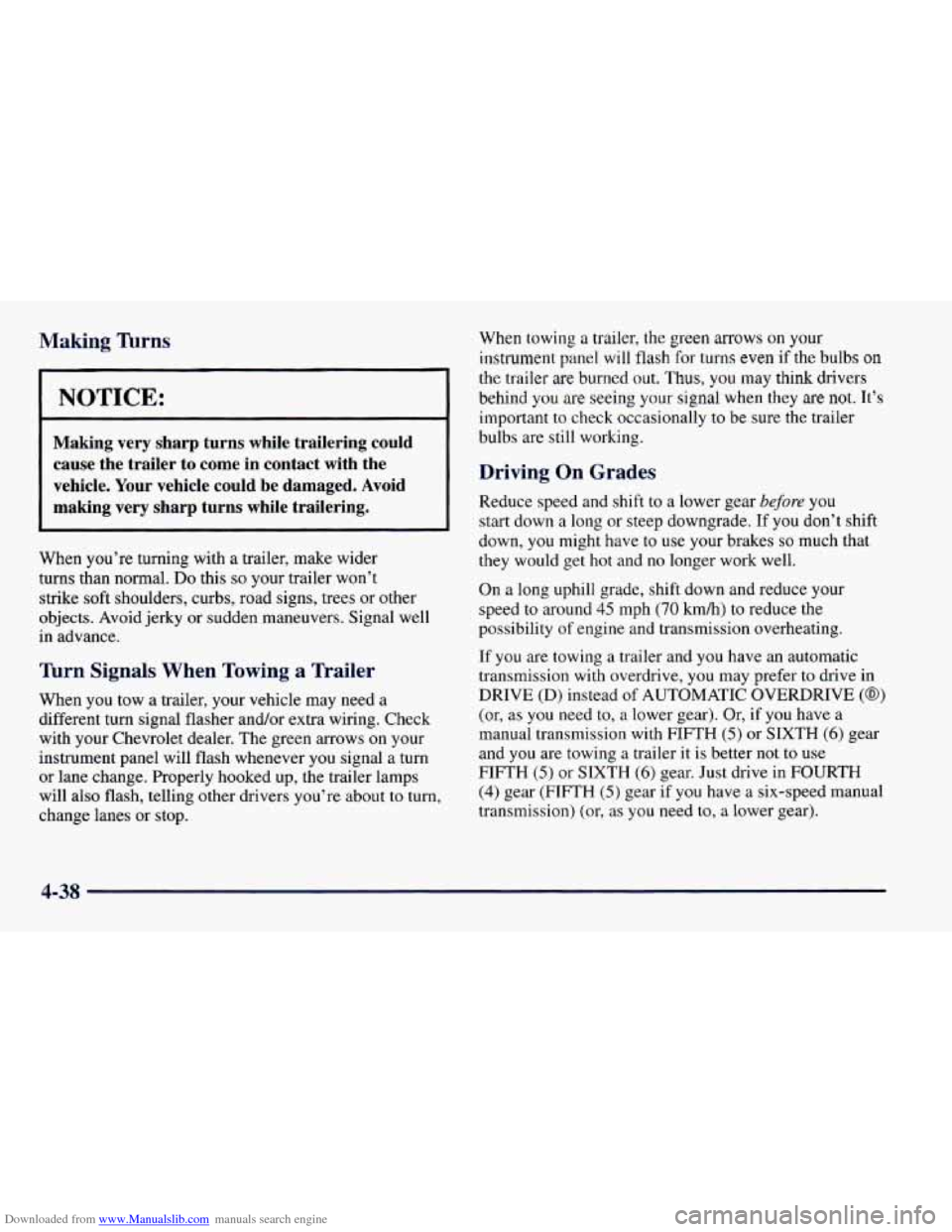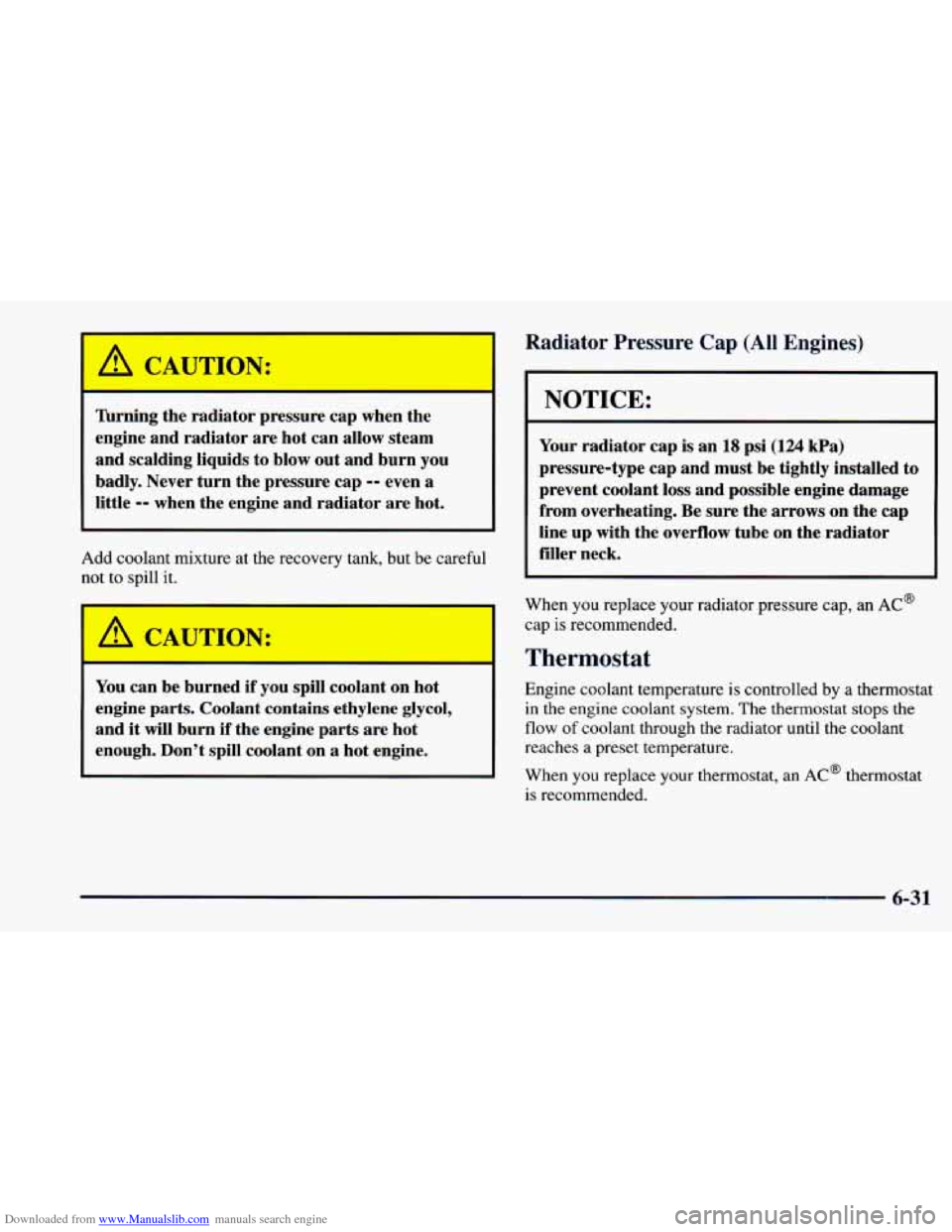Page 144 of 404

Downloaded from www.Manualslib.com manuals search engine Heating
The heater works best if you keep your windows closed
while using it.
1. Turn the air control knob to HEATER.
2. Turn the fan control knob to the desired speed.
3. Turn the temperature control knob to a
If your vehicle is equipped with an optional engine coolant
heater,
you can use it in cold weather (around 20 “F/-8 “C
or lower)
to improve heater performance on initial start up.
Because an engine coolant heater warms the engine
coolant, your vehicles heating system can more quickly
and efficiently provide heat for your vehicle’s passenger
area.
See “Engine Coolant Heater” in the Index.
Bi-Level Heating
You may want to use bi-level heating on cool, but sunny
days. This setting directs cool air toward your body and
warmer air toward your feet.
1. Turn the air control knob to BI-LEVEL.
2. Turn the temperature control knob to a
3. Turn the fan control knob to the desired speed.
comfortable
setting.
comfortable setting.
Ventilation System
Adjust the direction of airflow by moving the louvered vents.
Your Chevrolet’s flow-through ventilation system
supplies outside air into the vehicle when it is moving.
Outside air will also enter the vehicle when the blower
fan is running.
For mild outside temperatures when little heating or
cooling is needed, you can still direct outside air through
your vehicle.
1. Turn the air control knob to VENT.
2. Turn the temperature control knob to a
comfortable setting.
3. Turn the fan control knob to the desired speed.
3-4
Page 202 of 404

Downloaded from www.Manualslib.com manuals search engine Making firns
I NOTICE:
Making very sharp turns while trailering could cause the trailer to come in contact with the
vehicle. Your vehicle could be damaged. Avoid
making very sharp turns while trailering.
When you’re turning with a trailer, make wider
turns than normal.
Do this so your trailer won’t
strike soft shoulders, curbs, road signs, trees or other
objects. Avoid jerky or sudden maneuvers. Signal well
in advance.
%rn Signals When Towing a Trailer
When you tow a trailer, your vehicle may need a
different turn signal flasher and/or extra wiring. Check
with your Chevrolet dealer. The green arrows
on your
instrument panel will flash whenever
you signal a turn
or lane change. Properly hooked up, the trailer lamps
will also flash, telling other drivers you’re about to turn,
change lanes or stop. When
towing
a trailer, the green arrows on your
instrument panel will flash for turns even if the bulbs on
the trailer are burned out. Thus, you may think drivers
behind
you are seeing your signal when they are not. It’s
important
to check occasionally to be sure the trailer
bulbs are still working.
Driving On Grades
Reduce speed and shift to a lower gear before you
start down a long or steep downgrade. If you don’t shift
down, you might have to
use your brakes so much that
they would get hot and no longer work well.
On a long uphill grade, shift down and reduce your
speed
to around 45 mph (70 km/h) to reduce the
possibility of engine and transmission overheating.
If
you are towing a trailer and you have an automatic
transmission with overdrive,
you may prefer to drive in
DRIVE
(D) instead of AUTOMATIC OVERDRIVE (@)
(or, as you need to, a lower gear). Or, if you have a
manual transmission with FIFTH (5) or SIXTH (6) gear
and
you are towing a trailer it is better not to use
FIFTH
(5) or SIXTH (6) gear. Just drive in FOURTH
(4) gear (FIFTH (5) gear if you have a six-speed manual
transmission) (or, as
you need to, a lower gear).
4-38
Page 205 of 404
Downloaded from www.Manualslib.com manuals search engine 0 Section 5 Problems on the Road
Here you’ll find what to do about some problems that can occur on the road.
5-2
5-3
5-8
5-14
Hazard Warning Flashers
Jump Starting
Towing Your Vehicle
Engine Overheating 5-28
5-29
5 -40
5-4 1
If a Tire Goes Flat
Changing a Flat Tire
Compact Spare Tire
If You’re Stuck: In Sand, Mud,
Ice or Snow
5-1
Page 218 of 404

Downloaded from www.Manualslib.com manuals search engine 'Engine Overheating
You will find a coolant temperature gage on your
Chevrolet's instrument panel. You may also find a LOW
COOLANT warning light on your Chevrolet's
instrument panel.
(V8 Engine Only)
If Steam Is Coming From Your Engine
t A
/! CAUTION:
Steam from an overheated engine can burn
badly, even if you just open the hood. Stay away
from the engine
if you see or hear steam coming
from it. Just turn
it off and get everyone away
from the vehicle until it cools down. Wait until
there
is no sign of steam or coolant before you
open the hood.
If you keep driving when your engine is
overheated, the liquids in it can catch fire. You or
others could be badly burned. Stop your engine
if
it overheats, and get out of the vehicle until the
engine is cool.
I NOTICE:
~~ ~
If your engine catches fire because you keep
driving with no coolant, your vehicle can be
badly damaged. The costly repairs would not be
covered
by your warranty.
5-14
Page 221 of 404
Downloaded from www.Manualslib.com manuals search engine When it is cool, remove the coolant recovery tank cap
and look at the dipstick.
The coolant level should be
at FULL COLD.
If it isn’t, you may have a leak in the radiator hoses,
heater hoses, radiator, water pump or somewhere
else in
the cooling system.
Heater and radiator hoses, and other engine
parts, can be very hot. Don’t touch them.
If you
do, you can be burned.
Don’t run the engine if there
is a leak. If you run
the engine, it could lose all coolant. That could
cause an engine fire, and you could be burned.
Get any leak fixed before you drive the vehicle.
NOTICE:
Engine damage from running your engine
without coolant isn’t covered
by your warranty.
If there seems to be no leak, with the engine on, check to
see if the electric engine fan is running. If the engine is
overheating, the fan should be running. If it isn’t, your
vehicle needs service.
5-17
Page 274 of 404

Downloaded from www.Manualslib.com manuals search engine Engine Coolant
The cooling s stem in your vehicle is filled with
DEX-COOL engine coolant. This coolant is designed
to remain
in your vehicle for 5 years or 150,000 miles
(240 000 km) whichever occurs first, if you add only
DEX-COOL’ extended life coolant.
The following explains your cooling system and how to
add coolant when it
is low. If you have a problem with
engine overheating or
if you need to add coolant to your
radiator, see “Engine Overheating” in the Index.
d
A 50/50 mixture of water and DEX-COOL@
coolant will:
0 Give freezing protection down to -34°F (-37°C).
0 Give boiling protection up to 265 “F (1 29°C).
0 Protect against rust and corrosion.
0 Help keep the proper engine temperature.
0 Let the warning lights and gages work as
they should.
NOTICE:
When adding coolant, it is important that you use
only
DEX-COOL@ (silicate-free) coolant.
If silicated coolant is added to the system,
premature engine, heater core
or radiator
corrosion may result. In addition, the engine
coolant
will require change sooner -- at
30,000 miles (50 000 km) or 24 months,
whichever occurs first.
6-28
Page 276 of 404
Downloaded from www.Manualslib.com manuals search engine Checking Coolant
5.7L Engine Only
When your engine is cold, check the dipstick on the cap
of the coolant recovery tank. The coolant level should
be at
COLD, or a little higher. When your engine is
warm, the level on the dipstick should be up to HOT,
or a little higher.
If this light comes on, it
means you’re low on
engine coolant.
Adding Coolant to the Recovery Tank
If you need more coolant, add the proper DEX-COOL’
coolant mixture at the coolant recovery tank, but only
when your engine is cool.
If the tank is very low or
empty, also add coolant to the radiator. See “Engine
Overheating” in the Index for information.
Page 277 of 404

Downloaded from www.Manualslib.com manuals search engine A CAUTION:
Turning the radiator pressure cap when the
engine and radiator are hot can allow steam
and scalding liquids
to blow out and burn you
badly. Never turn the pressure cap
-- even a
little -- when the engine and radiator are hot.
Add coolant mixture at the recovery tank, but be careful
not to spill it.
'
A CAUTION:
You can be burned if you spill coolant on hot
engine parts. Coolant contains ethylene glycol,
and
it will burn if the engine parts are hot
enough. Don't spill coolant on a hot engine.
Radiator Pressure Cap (All Engines)
NOTICE:
Your radiator cap is an 18 psi (124 kPa)
~ pressure-type cap and must be tightly installed to
~ prevent coolant loss and possible engine damage
from overheating. Be sure the arrows on the cap
line up with the overflow tube on the radiator
filler neck.
When you replace your radiator pressure cap, an AC@
cap
is recommended.
Thermostat
Engine coolant temperature is controlled by a thermostat
in the engine coolant system. The thermostat stops the
flow of coolant through the radiator until the coolant
reaches a preset temperature.
When you replace your thermostat, an AC@ thermostat
is recommended.
6-31